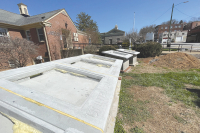Special places define us
One never tires of discovering special places here in the southern mountains. Through the years, such places readily become old and reliable friends.
The little cove we live in several miles west of Bryson City is one such place. Surrounded on three sides by the Great Smoky Mountains National Park, it’s secluded and quiet. We've been here since 1976 and continue to be renewed by the terrain, plants, and animals.
It’s a pretty commonplace cove. There are no rare plants or birds. The view from the front porch down the creek is comforting, but not sensational. There’s something about this little patch of land that keeps us going.
Back in the early 1990s we had to move everyone into a large house in town for seven months because of my mother's declining health. That's when we found out just how much that spot out in the country, away from street lights and sirens, meant to us — how fully it had become a defining factor in our lives. Once we had returned to the cove after mother’s death, we felt more certain of our place and direction in life. There was quite clearly no place else we wanted or needed to be.
I suspect everyone reading this knows precisely what I’m talking about in regard to the attachments associated with one's home place. Our emotional ties to specific places can sometimes be as ingrained as our ties to certain people; indeed, our most deeply rooted feelings about certain people are often associated with specific places. That’s surely one of the reasons why the families of those moved out of the lands now occupied by the Great Smoky Mountains National Park are so reluctant to let the road and cemetery issues die. Those issues are, after all, emblems signifying an attachment to certain old home places and not-yet-forgotten people.
Beyond individual home places, there are special places that we discover and continue to visit because of their intrinsic beauty. Almost every year, my wife, Elizabeth, and I revisit the Alarka Laurel tract situated high in the Cowee Mountains between Bryson City and Franklin. It was one of the first places we discovered with our then small (now grown) children back in the early 1970s, when we moved to Western North Carolina. Now on U.S. Forest Service lands, it’s a fairly remote setting, featuring a mountain bog, brook trout, and a nature trail that winds through the southernmost stand of red spruce in North America.
Related Items
Little Creek Falls, situated above Ela, N.C., off Cooper Creek on the trail to Deeplow Gap, was also discovered back when our children were young. We would often hike there to picnic. It's not a grand waterfall, but it’s seldom visited and just right for a family outing. The trail alongside and across Little Creek switchbacks, spiraling upward through a wonderland of wildflowers: showy orchis, yellow mandarin, bellwort, hepatica, lady rue, umbrella leaf, flame azalea, and more.
Most special places are discovered by chance. Some years ago, while scouting for a good location to take a Southwestern Community College wildflower identification class, I pulled my truck over at an unlikely looking spot on the Cherokee Indian Reservation. But after rock hopping across a creek adjacent to the roadway, I suddenly found myself in one of the most attractive settings one could ever hope to blunder upon.
There was an extensive boulderfield, dating perhaps from the last Ice Age, in which rock after mossy rock was covered with stands of rare walking ferns. The same boulders were covered with moss mats in which various trillium species, Dutchman’s-britches, squirrel corn, cut-leaved toothworth, rockcap fern, wild ginger, northern white violets, and other showy Appalachian plants were flourishing.
Down from the boulderfield in an open area, I wandered into a large colony of dwarf delphinium. It was the first unreported station of that species in Western North Carolina that I’ve ever discovered. If you've never viewed dwarf delphinium in all its purple-blooming glory, your life is incomplete. Farther on was a little glade with plants I’d never previously encountered except in botanical manuals.
It was a fairyland setting of tumbling water, mossy boulderfields, upland glades, and rare wild plants. Elizabeth and I go back there periodically to make sure it was real, not just a dream I'd had. So far, it’s always been there as I remembered it. We’d tell you where it is except that — as a general rule — it’s best to discover special places on your own.
Editor’s note: This column first appeared in The Smoky Mountain News in March 2006.
George Ellison is a naturalist and writer. He can be reached at This email address is being protected from spambots. You need JavaScript enabled to view it..









